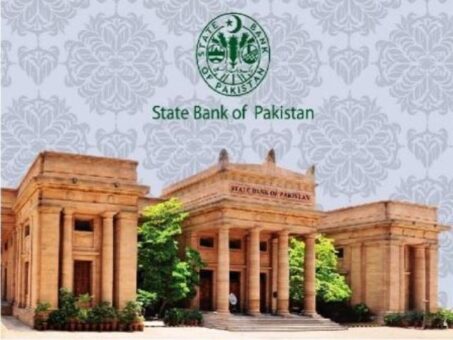KARACHI: State Bank of Pakistan (SBP) on Friday surprised the market with a massive hike in policy rate by 100 basis points to 16 per cent.
Analysts at Arif Habib Limited said that in the monetary policy meeting held on November 25, 2022, the SBP hiked the benchmark policy rate by 100 basis points to 16 per cent.
To recall, the last hike of 125 basis points was done in July 2022. The current stance aims to contain the impact of elevated domestic inflationary pressure, so as to embark on a path of sustainable recovery.
Three key observations since the last MPC:
READ MORE: SBP raises benchmark interest rate by 100 basis points to 16pc
The MPC highlighted the following developments since the meeting in October 2022.
Firstly, global and domestic supply shocks have increasing pushed Consumer Price Index (CPI) higher. These have spilled over in broader prices and wages (cost-push), and upstretched inflation expectations while also undermining medium-term growth. Headline inflation rose sharply in October 2022 by 3.5 per cent to 26.6 per cent YoY driven by a normalization of fuel cost adjustments in electricity tariffs, and higher food prices.
Crop damage post recent floods has increased food prices by 35.7 per cent YoY, and core inflation to 18.2 per cent YoY. It remains pertinent to curb food inflation through administrative controls and necessary imports.
Inflation expectations of the MPC for FY23 revised up to 21-23 per cent from 18-20 per cent previously.
READ MORE: SBP keeps policy rate unchanged at 15% amid economic deceleration
Secondly, external account challenges persevere despite a sharp cut in imports in September 2022 and October 2022, as well as fresh funding from the ADB.
Lastly, projections for GDP growth of 2 per cent and CAD of 3 per cent of GDP for FY23 shared in the last policy have been maintained after incorporating the Post-Disaster Needs Assessment of the floods.
Economic activity as measured through demand indicators showed a double-digit decline on a YoY basis in October 2022 since the last MPC meeting on the back of “disruptions from floods and on-going policy and administrative measures.”
Electricity generation declined for a fifth straight month, down 5.2 per cent YoY.
Although export-oriented sectors contributed positively, LSM remained flat against last year.
Factors that will keep the GDP growth tepid include sizeable damage to rice and cotton crop, as well as slow growth in the manufacturing and construction sectors.
CAD during 4MFY23 fell to USD 2.8 billion, almost half of the levels seen in the same period of last year. This was attributable to a 11.6 per cent dip in imports to USD 20.6 billion coupled with a 2.6 per cent jump in exports to USD 9.8 billion.
Albeit, remittances compressed by 8.6 per cent to USD 9.9 billion, “reflecting a widening gap between the interbank and open market exchange rate, normalization of travel and US dollar strengthening.”
READ MORE: SBP keeps benchmark rate unchanged at 15% amid rising inflation
Net inflows on the financial side dropped to USD 1.9 billion during 4MFY23 vs. USD 5.7 billion last year amid domestic uncertainty and tighter global financial conditions as major central banks are adopting rate hikes.
CAD is projected to remain moderate in FY23 as augmented imports of cotton and lower exports of rice and textile are expected to be offset by a continued slide in impost in lieu of economic slowdown and softer global commodity prices.
With the materialization of anticipated external flows from bilateral and multilateral sources, a gradual improvement is expected in FX reserves.
Pressure on the current account could further lose steam if there is a notable decline in global oil prices or “the pace of rate hikes by major central banks slows.”
Fiscal outcomes deteriorated in 1Q relative to last year, despite the budgeted consolidation, with fiscal deficit arriving at 1 per cent of GDP compared to 0.7 per cent, and primary surplus shrinking to 0.2 per cent of GDP from 0.3 per cent. This was primarily due to a decline in non-tax revenue and augmented interest payments. Simultaneously, growth in FBR’s tax revenues more than halved in 4MFY23.
Several relief measures are being executed for the agriculture sector such as mark-up subsidies for farmers and the provision of subsidized inputs, in response to the floods. While it will be pertinent to minimize fiscal slippages by re-routing expenditure and foreign grants to meet additional needs, the floods certainly pose a threat to the aggressive fiscal consolidation budgeted this year.
READ MORE: Poll sees no policy rate change in August 22, 2022 meeting
Fiscal discipline complemented by monetary tightening will help prevent an entrenchment of inflation, and lower external vulnerabilities.
Private sector credit offtake also showed moderation, increasing by just PKR 86.2 billion in 1Q against PKR 226.4 billion last year, given lower working capital loans to wholesale and retail trade services, and textile sector amid reduced cotton output, as well as slowdown in consumer finance.
Medium-term target for inflation is the upper range of the 5-7 per cent by the end of FY24, “supported by prudent macroeconomic policies, orderly Rupee movement, normalizing global commodity prices and beneficial base effects.”
